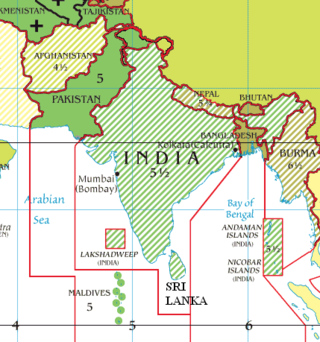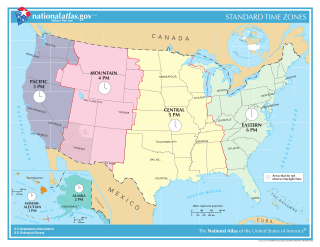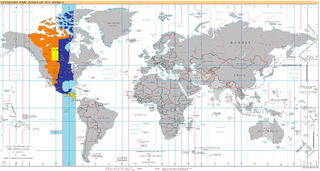
Michigan observes Eastern Time, except for four counties and two cities, which observe Central Time.

Michigan observes Eastern Time, except for four counties and two cities, which observe Central Time.
Before time zones were introduced, every place used local observation of the sun to set their clocks, which means they used local mean time, every city different based on their longitude. Detroit used 05:32:11 west of Greenwich and Menominee 05:50:27 west of Greenwich.
Time zones were introduced in the United States in 1883. They were introduced in different years based on local decisions. Michigan adopted Central Standard Time throughout the state effective September 18, 1885. [1] [2] [3] In 1915, Detroit changed to Eastern time, followed by most of the rest of the state in 1931. [4]
In 1967, when the Uniform Time Act came into effect, the Upper Peninsula went under year-round CST, with no daylight saving time. [5] In 1973, the majority of the peninsula switched to Eastern Time; [6] only the four western counties of Gogebic, Iron, Dickinson, and Menominee continue to observe Central Time.
The zone for Michigan as given by zone.tab of the IANA time zone database [7]
| c.c. | coordinates | TZ | comments | UTC offset | UTC offset DST | Note |
|---|---|---|---|---|---|---|
| US | +421953−0830245 | America/Detroit | Eastern - MI (most areas) | −05:00 | −04:00 | |
| US | +450628−0873651 | America/Menominee | Central - MI (Wisconsin border) | −06:00 | −05:00 | Was used statewide from January 1, 1905 until May 15, 1915. This was prior to the advent of DST, so UTC-6 was used all year long |

A time zone is an area which observes a uniform standard time for legal, commercial and social purposes. Time zones tend to follow the boundaries between countries and their subdivisions instead of strictly following longitude, because it is convenient for areas in frequent communication to keep the same time.

The Upper Peninsulaof Michigan – also known as Upper Michigan or colloquially the U.P. – is the northern and more elevated of the two major landmasses that make up the U.S. state of Michigan; it is separated from the Lower Peninsula by the Straits of Mackinac. It is bounded primarily by Lake Superior to the north, separated from the Canadian province of Ontario at the east end by the St. Marys River, and flanked by Lake Huron and Lake Michigan along much of its south. Although the peninsula extends as a geographic feature into the state of Wisconsin, the state boundary follows the Montreal and Menominee rivers and a line connecting them.

Japan Standard Time, or Japan Central Standard Time, is the standard time zone in Japan, 9 hours ahead of UTC (UTC+09:00). Japan does not observe daylight saving time, though its introduction has been debated on several occasions. During World War II, the time zone was often referred to as Tokyo Standard Time.

The history of standard time in the United States began November 18, 1883, when United States and Canadian railroads instituted standard time in time zones. Before then, time of day was a local matter, and most cities and towns used some form of local solar time, maintained by some well-known clock. The new standard time system was not immediately embraced by all.

The North American Central Time Zone is a time zone in parts of Canada, the United States, Mexico, Central America, some Caribbean islands, and part of the Eastern Pacific Ocean.

The Eastern Time Zone (ET) is a time zone encompassing part or all of 23 states in the eastern part of the United States, parts of eastern Canada, and the state of Quintana Roo in Mexico.

Indian Standard Time (IST), sometimes also called India Standard Time, is the time zone observed throughout India, with a time offset of UTC+05:30. India does not observe daylight saving time or other seasonal adjustments. In military and aviation time, IST is designated E* ("Echo-Star"). It is indicated as Asia/Kolkata in the IANA time zone database.

The Alaska Time Zone observes standard time by subtracting nine hours from Coordinated Universal Time (UTC−09:00). During daylight saving time its time offset is eight hours (UTC−08:00). The clock time in this zone is based on mean solar time at the 135th meridian west of the Greenwich Observatory.

In the United States, time is divided into nine standard time zones covering the states, territories and other US possessions, with most of the country observing daylight saving time (DST) for approximately the spring, summer, and fall months. The time zone boundaries and DST observance are regulated by the Department of Transportation, but no single map of those existed until the agency announced intentions to make one in September 2022. Official and highly precise timekeeping services (clocks) are provided by two federal agencies: the National Institute of Standards and Technology (NIST) ; and the United States Naval Observatory (USNO). The clocks run by these services are kept synchronized with each other as well as with those of other international timekeeping organizations.

UTC−05:00 is an identifier for a time offset from UTC of −05:00. In North America, it is observed in the Eastern Time Zone during standard time, and in the Central Time Zone during the other eight months. The western Caribbean uses it year round.

Summer time in Europe is the variation of standard clock time that is applied in most European countries in the period between spring and autumn, during which clocks are advanced by one hour from the time observed in the rest of the year, with a view to making the most efficient use of seasonal daylight. It corresponds to the notion and practice of daylight saving time (DST) to be found in some other parts of the world.

The Atlantic Time Zone is a geographical region that keeps standard time—called Atlantic Standard Time (AST)—by subtracting four hours from Coordinated Universal Time (UTC), resulting in UTC−04:00. AST is observed in parts of North America and some Caribbean islands. During part of the year, some portions of the zone observe daylight saving time, referred to as Atlantic Daylight Time (ADT), by moving their clocks forward one hour to result in UTC−03:00. The clock time in this zone is based on the mean solar time of the 60th meridian west of the Greenwich Observatory.

Hong Kong Time is the time in Hong Kong, observed at UTC+08:00 all year round. The Hong Kong Observatory is the official timekeeper of the Hong Kong Time. It is indicated as Asia/Hong_Kong in the IANA time zone database.

The Newfoundland Time Zone (NT) is a geographic region that keeps time by subtracting 3.5 hours from Coordinated Universal Time (UTC) during standard time, resulting in UTC−03:30; or subtracting 2.5 hours during daylight saving time. The clock time in this zone is based on the mean solar time of the meridian 52 degrees and 30 arcminutes west of the Greenwich Observatory. It is observed solely in the Canadian province of Newfoundland and Labrador. The Newfoundland Time Zone is the only active time zone with a half-hour offset from UTC in the Americas.

UTC−06:00 is an identifier for a time offset from UTC of −06:00. In North America, it is observed in the Central Time Zone during standard time, and in the Mountain Time Zone during the other eight months. Several Latin American countries and a few other places use it year-round.

Australia uses three main time zones: Australian Eastern Standard Time, Australian Central Standard Time and Australian Western Standard Time.

Canada is divided into six time zones. Most areas of the country's provinces and territories operate on standard time from the first Sunday in November to the second Sunday in March and daylight saving time the rest of the year.

Most of the United States observes daylight saving time, the practice of setting the clock forward by one hour when there is longer daylight during the day, so that evenings have more daylight and mornings have less. Exceptions include Arizona, Hawaii, and the overseas territories of American Samoa, Guam, the Northern Mariana Islands, Puerto Rico, and the United States Virgin Islands. The Uniform Time Act of 1966 established the system of uniform daylight saving time throughout the US.

Ireland uses Irish Standard Time in the summer months and Greenwich Mean Time in the winter period.
... among the laws now in force are the 10-hour labor law and an enactment making central standard time legal in this State.
Standard time becomes legal in Michigan this morning.